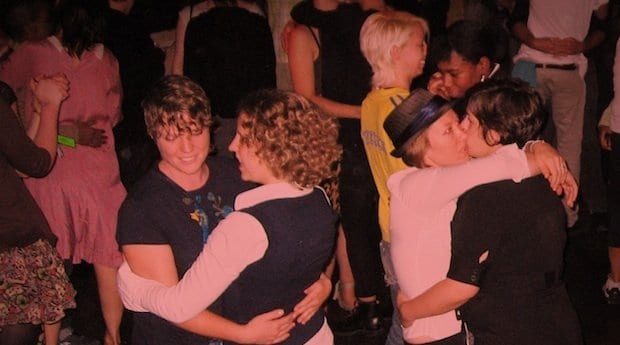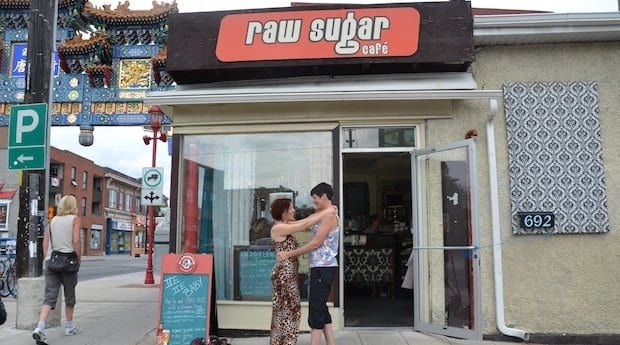
Organizers of the Ottawa Dyke March are hosting a slowdance on Aug 26 to raise funds for their post-march picnic. Credit: Sherwin Sullivan Tjia
High school dances are something almost all of us remember. But like many of the common experiences of adolescence, some of us have mixed feelings about them. And for people in the queer community, feelings about dances can be even more complicated.
For those who were closeted in high school, or who were still discovering their sexualities, dances could be the epitome of social anxiety. But often it’s the execution, and not the concept, that can make or break an event.
Joanne Bradley, fundraising coordinator with the Ottawa Dyke March, certainly thinks so. She reached out to Ottawa organizer Luna Allison to plan a slowdance night at Raw Sugar Café that will raise some much-needed funds for the Dyke March. The dance will be held on July 26 and will provide a safe queer- and trans-positive space for people to come together and sway to the music.
“There’s something really — can I use the word magical? — about [a slowdance],” Bradley says. “It’s just — it’s really amazing, and I thought, ‘That’s an event that people will come to.”
Her instincts seem to have been right: a Facebook event for the dance already has close to 100 takers. Proceeds from the evening will be put to use by Dyke March organizers to cover the costs of a picnic held at Minto Park after they march down Bank Street on Aug 23.
Allison credits the concept behind the slowdance nights to Sherwin Sullivan Tjia, who runs dances in Montreal and Toronto. The concept is simple: pay $10 at the door and receive a dance card, which you can use to sign up with different partners throughout the evening.
There will be four 10-song sets with breaks in between, and designated dancers will be on hand throughout the night to gently guide wallflowers and those who are shyer about finding partners out onto the dancefloor. If the cover charge presents a barrier, Bradley says would-be participants can volunteer to help with setup and tear-down or to work a shift at the door.
Since their inception, slowdance nights have been very popular among queer women, Allison says. “I think there’s an appeal of romance,” she says. “There’s an opportunity to, like, spend time with somebody, it’s a low commitment, it’s a safe environment, you get to encounter a whole bunch of people in a room all at once. It’s a little bit like speed dating, but safer.”
The dance will be open to everyone, from the queer community to straight allies. “You don’t have to be queer to attend — just awesome,” Allison says. As long as everyone who attends is respectful and willing to take “no” for an answer, they’re free to participate, she says.
With its cozy vintage aesthetic, Bradley says Raw Sugar provides a great backdrop for the dance. For the event itself, the tables will be cleared out to provide more space for dancing and better access for people with disabilities.
Bradley says slowdances can be a great chance to meet people in a casual, low-stakes environment. “When I went to my first one, I was a little nervous,” she says. “But the first person I ran into was a friend — just a platonic friend, and right away we had a slowdance.”
The close quarters and lower music levels mean there’s more of an opportunity for conversation than the typical clubbing experience would offer. “But also, if you’re too shy to talk, you can get a little bit closer and you don’t have to make eye contact and you don’t have to talk,” Allison says. “You can just kind of listen to the music and enjoy the touch and just be in the moment.”
Because everyone is there to slowdance, going up to someone and asking doesn’t carry the same kind of pressure it normally would, she says. “You ask someone to dance, and there’s a really good chance they’re not going to say no,” Bradley adds. The music for the night will reflect the theme — Rainbow Heat — including songs like Lady in Red and True Colors.
While the queer community can sometimes have its disagreements, Allison says, events like the slowdance can be a good opportunity to put differences aside and just enjoy each other’s company. “I think given all the drama that does happen in our communities and all of the political disagreements and stuff like that, it’s really nice to just like . . . hold each other.”
Queer Slowdance Night: Rainbow Heat Edition
Fundraiser for the Ottawa Dyke March
Sat, July 26, 9pm–1am
Raw Sugar Café, 692 Somerset St W
$10
facebook.com/events/1432705720348785


 Why you can trust Xtra
Why you can trust Xtra


